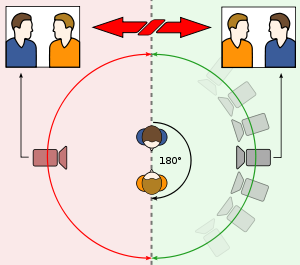What Is The 180 Degree Rule?
One of the most basic guidelines in making a film, the 180 degree rule, helps the audience comprehend the relationship of the characters and things in a scene. An imaginary line, sometimes called the axis, is drawn through the key characters and/or objects in a scene. By keeping the camera on one side of this axis for all the shots of the scene the characters will always appear to keep a logical relationship to each other on the screen. The 180 degree rule is a fundamental concept of continuity editing.Changing the point of observation across the line might appear to the audience that the actors have suddenly jumped to another places in the scene. If the film director always obeys the 180 degrees rule the audience will be better able to understand the narrative with no uncertainty.
Observing the 180 degree rule is especially crucial throughout chase sequences involving two actors. If the action is first seen moving from left to right after that all shots in the chase need to maintain that orientation to keep it from seeming to the audience that the two characters have changed directions and the chase is now going in the opposite direction.
When the camera moves across the axis it is referred to as jumping the line or crossing the line. In reality such a change in viewpoint at some point in a chase sequence would only be appropriate in a comedy.
All the different shots taken of a scene for coverage need to follow the 180 degree rule unless the filmmaker has something special in mind.
How To Break the 180 Degree Rule
Creatively breaking the 180 degree rule will improve the movie storytelling when done properly. For example jumping the line may generate a subtle disorientation in the audience and consequently amplify emotional tension. A battle scene or a fast moving dance number would benefit from such a treatment. At times it may be required to have moving characters change direction and after that a shot needs to be inserted showing the characters turning a corner to preserve the logic of the movement.Within a scene where a character is discussing the pros and cons of something with himself it might be effective to alter the position of the camera to make the single character appear almost like two actors having a discussion. If two or more actors are altering positions in a scene as part of the action that might appear to break the 180 degree rule the director wants to be careful to put in a new establishing shot to make it clear to the audience what is happening.
